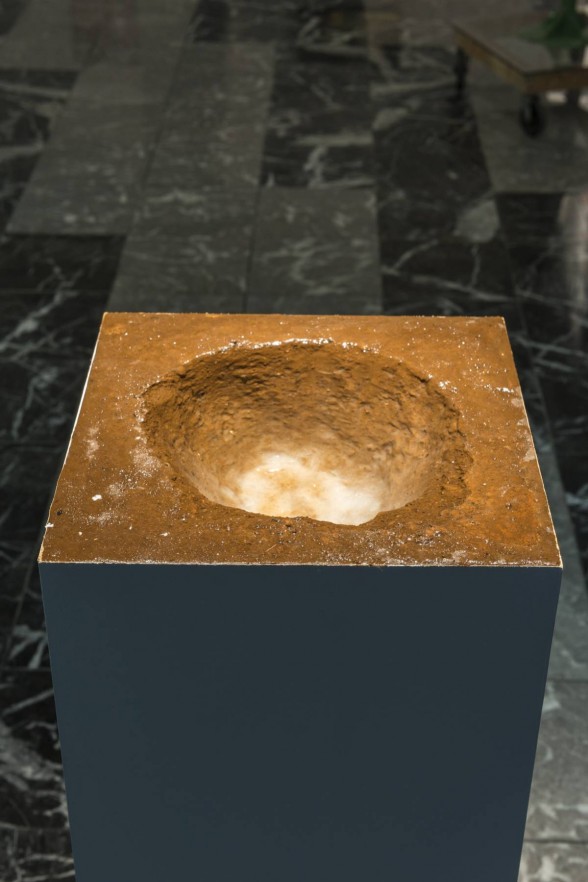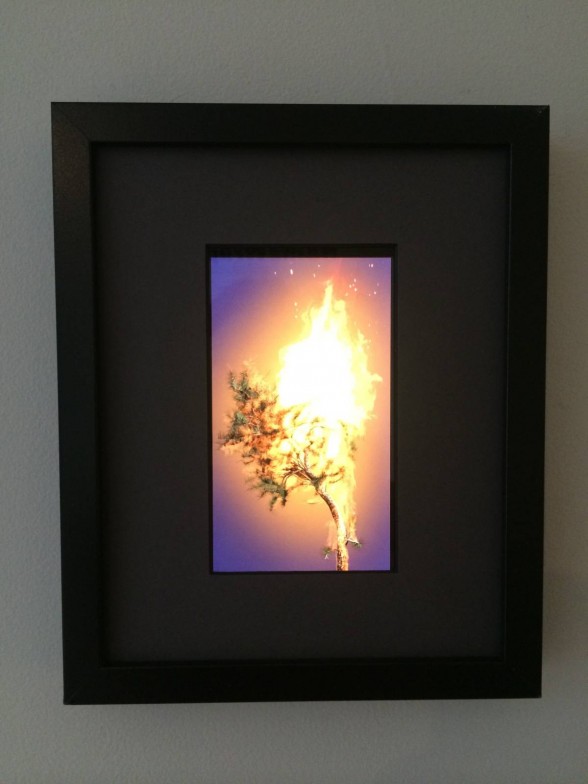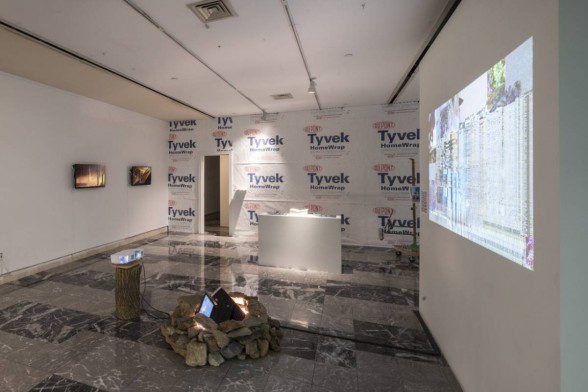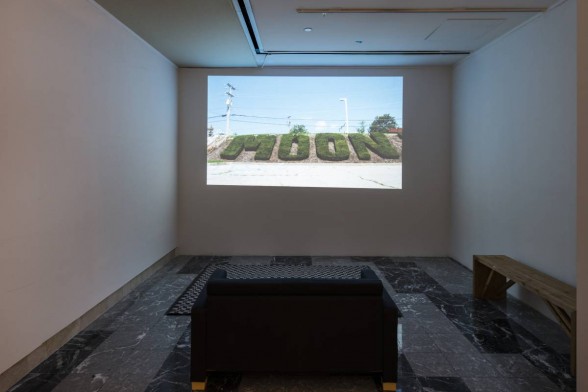[Marvin sets off through a relationship-based exhibition, particularly enjoying an evocative video work by David Scott Kessler, and suggesting that maybe, outer space is closer than we think. — the Artblog editors]
The Usable Earth, a new exhibit at the Esther Klein Gallery in the University City Science Center, addresses the ecological relationship between humans and Earth. Through a variety of media, the invited artists, architects, filmmakers, scholars, and authors examine the human-nature relationship. Some pieces, more than others, carry a certain subtle message: one that implies the enduring presence of a land once untouched by man. Several notable works highlight the eight-person show curated by artist and Vox Populi member Kristen Neville Taylor.
Open to interpretation

Two works by Austin, Texas artist TJ Hunt look at the changing relationship of landscape and the connection to place. One untitled piece appears to be a simple white pedestal, ready to display an artifact or sculpture. However, the pedestal’s unusual surface reveals a “dug” hole of brown earth filled with water. Any slight motion to the pedestal creates a harmonious ripple effect. Perhaps Hunt is commenting on the ongoing offshore drilling debate, or just the magnificence of underwater caves. Regardless, the piece is both deceptive and intriguing.

On an adjacent wall hangs another untitled work–a sloped bracket made out of steel and wood that encloses minute granules of black coal slag. By displaying the work on a gallery wall, Hunt elevates the status of the common material as something highly prized. Although Hunt’s work may appear simple in conception, she creates a sense of importance to these elements. Both works have traces of Minimalist aesthetics and Earth Art ideologies. Despite being separate pieces, the works inexplicably establish a relationship, one that demonstrates the cyclical process of digging into earth and gathering coal in order to fuel our everyday demands.
Burning Barrens
A prevailing theme in the work of filmmaker and video artist David Scott Kessler, a 2015 Pew Fellow, is fire as a source of destruction and rejuvenation. In “Burning Pitch Pine,” a startling digital animation of a burning tree is on loop. For Kessler, videographer of the 2007-2008 artblog series, “Look! It’s Libby and Roberta,” the video is a reminder of the value of fire to the expansive New Jersey Pine Barrens nature reserve. The spinning, burning tree alludes to the rejuvenating power of the fire-prone area, but some may read it as a symbol of the Biblical burning bush, or possibly as a reference to the myth of Prometheus, who brings fire to mankind from Mount Olympus.

“The Pine Barrens: Four Fires” is a video installation composed of two screens–one video documenting a violent, yet controlled fire in the Pine Barrens throughout the course of a day, and the other displaying people around a nighttime campfire. The juxtaposition of fire with nature and fire with humans in the two videos evokes a mystical, sublime quality that the Pine Barrens has become known for. In one film, the piercing forest fire set against the radiant colors of the sky from day to nightfall is quite meditative. In the other, that meditative tone transfers to an intimate campfire where people, young and old, discuss folk stories, such as the Jersey Devil, and personal stories over drinks and music. The short video is intermittently mixed with long scenes of close-ups of people and their surrounding area and voiceovers. Surprisingly, in one scene, a man starts a philosophical conversation about the existence and importance of fire while holding onto a flaming branch. Kessler’s work was quite the treat, and probably my favorite in the show. I’ll be watching out for any upcoming exhibitions he’s featured in.
Room for space

Across from Kessler’s two videos is a multimedia installation by artists Leila Nadir and Cary Peppermint, who work together under the collaborative name EcoArtTech. “Wilderness Collider” is a generative real-time Internet web app installation that uses people’s digital data, including tweets, texts, photos, and GPS coordinates from a mobile app called Indeterminate Hikes, which the artists also made. All this information from previous participants who have used the app is then intertwined into a moving-image collage. The artists encourage visitors to download the app–a QR code is available to scan in the gallery–and document their journeys into natural and urban settings. The collected imagery allows us to vicariously travel near and far with strangers and see evolving landscapes of the 21st century. EcoArtTech’s design of a campfire scene (log, a laptop computer, and rock pile) is not accidental. Similar to Kessler’s “The Pine Barrens: Four Fires” videos, the meta-campfire exemplifies a meeting place both in the real world and online for sharing life’s experiences.

The largest installation, The Eteam’s “The Backup Tapes from Moon and Mars,” is located in a separate gallery room. The exterior wall to this room is decorated with commercial Tyvek HomeWrap, a foundation wrap used during construction that keeps air and water out to protect homes. Inside the room are a couch, a rug, and a projection of the 33-minute film. In 2012, The Eteam (Franziska Lamprecht and Hajoe Moderegger, based in New York) visited the townships of Moon and Mars in Pennsylvania and acted as cultural anthropologists. The film portrays Moon and Mars as simulated environments that are training grounds to prepare humans to live beyond Earth. The Eteam’s “reports” are also documented in Buzz Cut, a small pocket book that accompanies the installation.
The film appropriately begins with Elvis Presley’s “Blue Moon,” followed by Andy Williams’ “Moon River”. The viewer is introduced to a brief history of Moon, Pennsylvania, and then is transported 40 minutes away to the township of Mars.
The Eteam records the everyday activities of Mars’ “inhabitants”–dropping off mail at the post office or exchanging words at the barbershop. The artists treat Moon and Mars as alluring foreign lands undiscovered by man, both mysterious and yet simplistic in their quiet suburbanesque lifestyles. The quest to reach the unknown is ironically reachable. Maybe the film sets a precedent for what to expect if we were to actually travel beyond Earth. What we have come to believe about life outside of Earth could just be as remote as the townships of Moon and Mars. This poignant feeling may dissatisfy anyone who has ever dreamed of becoming a space traveler.
Just outside the Science Center is an abundance of loud noise caused by construction and machinery. Ironically, a show examining the conflicting views of natural versus manmade is situated near a major development site with tons of steel, concrete, and glass. This startling juxtaposition of art and real-world development should strengthen the viewer’s impulse to be an environmentally cognizant and responsible individual.









